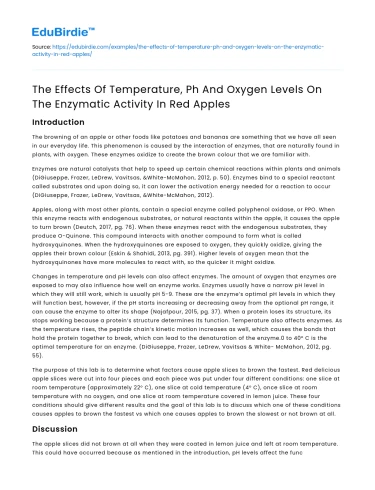Introduction
The browning of an apple or other foods like potatoes and bananas are something that we have all seen in our everyday life. This phenomenon is caused by the interaction of enzymes, that are naturally found in plants, with oxygen. These enzymes oxidize to create the brown colour that we are familiar with.
Enzymes are natural catalysts that help to speed up certain chemical reactions within plants and animals (DiGiuseppe, Frazer, LeDrew, Vavitsas, &White-McMahon, 2012, p. 50). Enzymes bind to a special reactant called substrates and upon doing so, it can lower the activation energy needed for a reaction to occur (DiGiuseppe, Frazer, LeDrew, Vavitsas, &White-McMahon, 2012).
Save your time!
We can take care of your essay
- Proper editing and formatting
- Free revision, title page, and bibliography
- Flexible prices and money-back guarantee
Apples, along with most other plants, contain a special enzyme called polyphenol oxidase, or PPO. When this enzyme reacts with endogenous substrates, or natural reactants within the apple, it causes the apple to turn brown (Deutch, 2017, pg. 76). When these enzymes react with the endogenous substrates, they produce O-Quinone. This compound interacts with another compound to form what is called hydroxyquinones. When the hydroxyquinones are exposed to oxygen, they quickly oxidize, giving the apples their brown colour (Eskin & Shahidi, 2013, pg. 391). Higher levels of oxygen mean that the hydroxyquinones have more molecules to react with, so the quicker it might oxidize.
Changes in temperature and pH levels can also affect enzymes. The amount of oxygen that enzymes are exposed to may also influence how well an enzyme works. Enzymes usually have a narrow pH level in which they will still work, which is usually pH 5-9. These are the enzyme’s optimal pH levels in which they will function best, however, if the pH starts increasing or decreasing away from the optional pH range, it can cause the enzyme to alter its shape (Najafpour, 2015, pg. 37). When a protein loses its structure, its stops working because a protein’s structure determines its function. Temperature also affects enzymes. As the temperature rises, the peptide chain’s kinetic motion increases as well, which causes the bonds that hold the protein together to break, which can lead to the denaturation of the enzyme.0 to 40° C is the optimal temperature for an enzyme. (DiGiuseppe, Frazer, LeDrew, Vavitsas & White- McMahon, 2012, pg. 55).
The purpose of this lab is to determine what factors cause apple slices to brown the fastest. Red delicious apple slices were cut into four pieces and each piece was put under four different conditions: one slice at room temperature (approximately 22° C), one slice at cold temperature (4° C), once slice at room temperature with no oxygen, and one slice at room temperature covered in lemon juice. These four conditions should give different results and the goal of this lab is to discuss which one of these conditions causes apples to brown the fastest vs which one causes apples to brown the slowest or not brown at all.
Discussion
The apple slices did not brown at all when they were coated in lemon juice and left at room temperature. This could have occurred because as mentioned in the introduction, pH levels affect the function of the enzymes since they have a certain range that they work the best under (Najafpour, 2015). Apples have a pH level of 5.0-5.5 while lemon juice has a pH level of 2.0 (Demirci & Ngadi, 2012, pg. 171), which is extremely acidic and this decrease in pH level may have denatured the PPO enzymes in the apple, hence no browning occurred. Furthermore, it illustrates that the apple slice left at room temperature browned the most and the slice left at 4° C was the 2nd most browned. This is not surprising because the optimal temperature range for enzyme function is from 0 to 40° C (DiGiuseppe, Frazer, LeDrew, Vavitsas & White-McMahon, 2012, pg. 55) and since the room temperature was 22° C, it makes sense for the apples to have browned so significantly. This also explains why the apple slice left at 4° C was the 2nd most browned. However, the result of the apple slice submerged in water makes the least sense. This was done to get rid of as much oxygen as possible because when phenolic compounds found within apples react with oxygen, they oxidize and give off a brown colour which can be stopped by immersing the apple in a brine or underwater (Msagati, 2013, pg. 112), but this was not result from the lab. This result may have occurred due to the apple slice being taken out of the water to be photographed. To prevent this from happening in future experiments, the apple can be photographed while it is still submerged in the water.
References
- Demirci, Ali Ngadi, Michael O.. (2012). Microbial Decontamination in the Food Industry - Novel Methods and Applications - 6.3.1.1 Juice Acidity. (pp. 171). Elsevier. Retrieved from https://app.knovel.com/hotlink/pdf/id:kt010XO7F3/microbial-decontamination/juice-acidity
- Department of Biology. (2020). Introductory cell biology laboratory. Waterloo, Canada: University of Waterloo Print + Retail Solution Deutch, C. E. (2017). Browning in apples: Exploring the biochemical basis of an easily- observable phenotype. Biochemistry and Molecular Biology Education, 46(1), pg. 76. doi: 10.1002/bmb.21083
- DiGiuseppe, M., Fraser, D., LeDrew, B., Vavitsas, A., & White-McMahon, M. (2012). 1.7: Enzymes. In Biology 12 (pp. 50-55). Toronto, Ont.: Nelson Education.
- Eskin, N.A. Michael Shahidi, Fereidoon. (2013). Biochemistry of Foods (3rd Edition). (pp. 391). Elsevier. Retrieved from https://app.knovel.com/hotlink/toc/id:kpBFE00012/biochemistry-foods-3rd/biochemistry-foods-3rd
- Msagati, Titus A. M.. (2013). Chemistry of Food Additives and Preservatives - 5.3.2 Enzymatic Browning Phenomena. (pp. 112). John Wiley & Sons. Retrieved from https://app.knovel.com/hotlink/pdf/id:kt011C1EK8/chemistry-food-additives/enzymatic-browning-phenomena
- Najafpour, Ghasem D.. (2015). Biochemical Engineering and Biotechnology (2nd Edition) - 2.11 Enzyme Deactivation. (pp. 37). Elsevier. Retrieved from https://app.knovel.com/hotlink/pdf/id:kt0114JPK3/biochemical-engineering/enzyme-deactivation
- https://app.knovel.com/hotlink/pdf/id:kt010XO7F3/microbial-decontamination/juice-acidity
- https://app.knovel.com/hotlink/pdf/id:kt010XO7F3/microbial-decontamination/juice-acidity
- https://app.knovel.com/hotlink/toc/id:kpBFE00012/biochemistry-foods-3rd/biochemistry-foods-3rd
- https://app.knovel.com/hotlink/toc/id:kpBFE00012/biochemistry-foods-3rd/biochemistry-foods-3rd
- https://app.knovel.com/hotlink/pdf/id:kt011C1EK8/chemistry-food-additives/enzymatic-browning-phenomena
- https://app.knovel.com/hotlink/pdf/id:kt011C1EK8/chemistry-food-additives/enzymatic-browning-phenomena
- https://app.knovel.com/hotlink/pdf/id:kt0114JPK3/biochemical-engineering/enzyme-deactivation
- https://app.knovel.com/hotlink/pdf/id:kt0114JPK3/biochemical-engineering/enzyme-deactivation






 Stuck on your essay?
Stuck on your essay?

